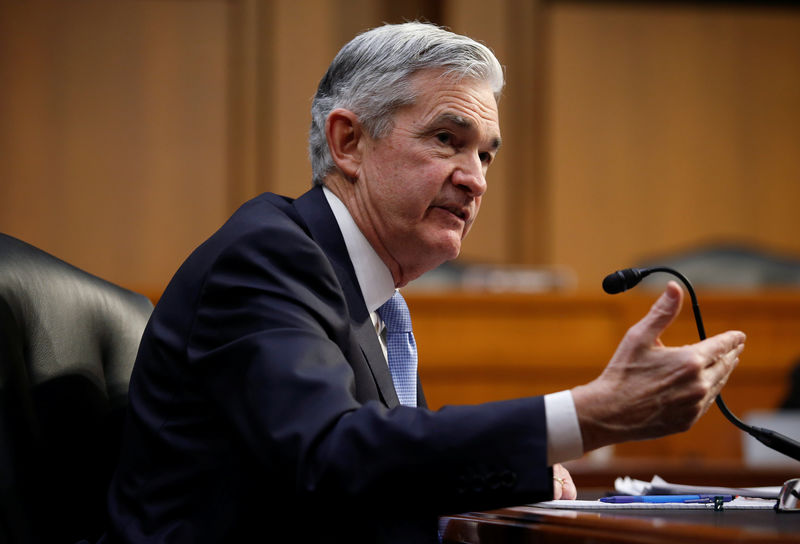 © Reuters. FILE PHOTO – Jerome Powell testifies on his nomination to become chairman of the U.S. Federal Reserve in Washington
© Reuters. FILE PHOTO – Jerome Powell testifies on his nomination to become chairman of the U.S. Federal Reserve in WashingtonBy Howard Schneider
WASHINGTON (Reuters) – As incoming Federal Reserve Chair Jerome Powell works through his holiday shopping list, he might consider the nearly 50 percent discount he could get buying Calvin Klein underwear online instead of at the local mall.
In the litany of reasons that explains why U.S. consumer price inflation has stalled, the drop in clothing prices last month, which was the largest in 20 years, takes its place alongside cheap cellphone contracts, one-off declines in drug prices and cheap gasoline, among others.
The Fed considers all of these price drops “transitory,” but there have been enough in a row for the central bank to miss its inflation target five years running, and fresh economic projections this week indicate policymakers remain mystified about why prices are not rising, given unemployment is at a 17-year low and the economy is growing steadily.
When the Fed met this week and raised short-term interest rates for the fifth time since late 2015, the inflation issue triggered two dissents among the nine voters on the policy-setting Federal Open Market Committee, and that division could widen.
“Inflation … is too low and has been for some time,” Chicago Fed President Charles Evans said in a dissenting statement on Friday.
Evans, who will not be voting on monetary policy in 2018, framed low inflation as a long-term problem if businesses and households stop believing the Fed is committed to its 2 percent inflation target.
A low but steady level of inflation is considered healthy in developed economies, but it depends importantly on public psychology and expectations that Evans said “appear to me to have drifted down.”
NEW CHAIR, OLD PROBLEM
The debate will likely dog Powell during his early months as Fed chief. It will be hard for the Fed to justify further rate increases unless inflation moves toward the central bank’s target.
That, in turn, would saddle Powell with exceptionally low interest rates, and little room to respond with rate reductions in the event of a recession.
Fed Chair Janet Yellen, in her final press conference as head of the central bank, had little advice other than to acknowledge that something may be fundamentally wrong about how the Fed looks at inflation, unemployment and the important relationship between them.
“I have tried to be straightforward in saying that this could end up being something that is more ingrained and turns out to be permanent. It’s very important to watch it and, if necessary, rethink,” Yellen told reporters on Wednesday, referring to the Fed’s inflation miss.
The economic projections issued this week after the Fed’s policy meeting contained what seems to be an internal tension.
Economic growth is forecast to accelerate next year, and unemployment to drop to 3.9 percent from the current 4.1 percent. That should put it at a level low enough to mean workers have leverage to demand wage increases and businesses feel emboldened to raise prices.
Yet inflation is not seen rising and the Fed did not say it expects to raise rates any faster then already planned.
Fed officials say their preferred forecast for inflation is around 1.7 percent for this year, rising to 1.9 percent in 2018, then reaching 2.0 percent in 2019 and staying there.
They have made similar projections in the past, and been wrong.
On the list of possible reasons, Yellen, like Evans, cited a possible slip in public expectations. She said the Fed may also simply misunderstand how inflation and unemployment relate in the current economy, with millions of working-age adults still on the sidelines of the job market, more choosing part-time work, and an expanding “gig economy.”
Theoretically, there is an unemployment rate below which inflation rises, and while estimates of that “have come down,” Yellen said, “it’s conceivable that they need to come down even more.”
In the projections last week, the median forecast of Fed officials kept that estimated “longer-run” unemployment rate at 4.6 percent. Yet they also saw unemployment averaging below 4 percent through 2020 without any appreciable jump in inflation, another seeming contradiction.
Retail experts and analysts who follow inflation say the Fed’s inflation outlook is not likely to get any help soon from the prices of clothes, home appliances, electronics, cars or other goods.
The 1.3 percent drop in apparel prices recorded in November was the largest since 1998, when the move to globalized supply chains and the integration of China into the world economy were still gaining momentum.
Now, it is the transformation of how things are sold and how consumers shop that is holding down prices, said Blerina Uruci, vice president of economic research at Barclays (LON:), and there is no sign of the process letting up soon.
The use of e-commerce sites like Amazon (NASDAQ:) still only accounts for about 10 percent of retail sales, Uruci noted, and the impact of technological innovation on sales and distribution will likely take years to run its course.
Meanwhile, consumers are becoming more adept with the tools at hand. Anyone looking for underwear in a brick-and-mortar store can quickly compare prices on a phone.
Technology is “allowing shoppers to push retailers towards a very competitive environment,” said Rick Helfenbein, president and chief executive officer of the American Apparel and Footwear Association.
“Retailers have reacted.”
Source: Investing.com



























